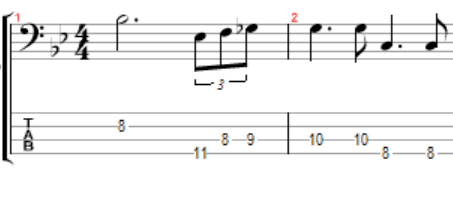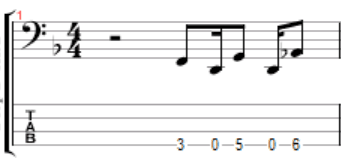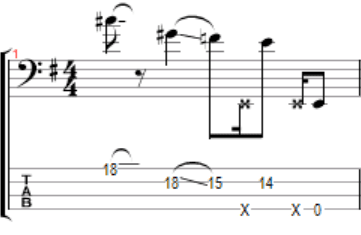Learning how to create bass fills is one of the most challenging aspects of playing the bass guitar.
Not only do you have to write a short melody that works well with the rest of your bassline. The fill also has to work with the other instruments in your band and feel like a natural transition between different parts of a song.
This can be a lot to take in at first. For that reason, I have made this list of 10 great bass fills that you can learn from.
Below, I`ve outlined why these bass fills work so well and how they add tension to the song. I`ll also show you how to apply the ideas behind these fills into your own playing.
As a result, you`ll develop a strong fundament for how to make better bass fills. You`ll also get plenty of ideas on when and how bass fills can be used to improve a song, and how to keep your fills interesting and varied.
1. Guns N` Roses – Sweet Child O` Mine
- Album: Appetite For Destruction
- Year: 1987
- Bassist: Duff McKagan
There are many unique things about Duff McKagan’s bass tone and playstyle. One signature of his is the way he plays fills that end earlier than one might expect.
One of the many songs where we can hear him doing this is “Sweet Child O` Mine”. At 1:14, Right before the chorus, he does a quick chromatic ascent to a high D. Then he plays a fast lick, but stops before the chorus hits and opts to slide down instead.

This works well because we are still feeling the tension of the fill when the chorus hits. At the same time, the song stops in its buildup for a small break, which makes the chorus sound louder and more impactful.
In other words, by stopping the fill early, Duff McKagan achieves the best of both worlds. Thus, this is an incredibly effective way of playing bass fills, and one that you can make great use of in any genre.
2. Queen – Killer Queen
- Album: Sheer Heart Attack
- Year: 1974
- Bassist: John Deacon
John Deacons P bass tone and melodic playstyle always ensured that Queen sounded well put together. “Killer Queen” in particular is a great song to learn from, as it is full of different bass fills.
After the first verse in the song, he plays a simple triplet that leads us into the pre-chorus. While simple, this is an extremely effective fill, as it quickly picks the song back up after it has slowed down.

Playing a fast triplet pattern in your fills will come in handy in many different situations. It`s great when moving from a slow to a fast part, or if a song comes to a complete halt.
It also works especially well with a drummer that plays the same rhythm. Thus, try this one out if you notice your drummer playing a triplet fill. Alternatively, try telling your drummer to copy your rhythm if you decide that the song calls for a triplet fill.
3. The Four Tops – Bernadette
- Album: Released as single
- Year: 1967
- Bassist: James Jamerson
“Bernadette” has one of the best soul basslines I`ve ever heard. On it, James Jamerson also plays an interesting fill that differs from the others on this list.
This is because he plays the fill at the end of the chorus. While bass fills are more often than not used to create buildup, Jamerson instead uses a fill here to create a crescendo.

The bass fill is both groovy and melodic, and it can be heard at 0:20 in the song. Most of the melodic movement in it is upwards in pitch. Thus, we are literally ending the chorus on a high note.
It`s therefore helpful to remember that bass fills don`t strictly have to make the following part of the song fit better. They can also be used to emphasize and improve the ending of the current part.
4. The Who – The Real Me
- Album: Quadrophenia
- Year: 1973
- Bassist: John Entwistle
In addition to being one of The Who`s best basslines, “The Real Me” has lots of great fills to draw inspiration from.
At 0:24 John Entwistle plays a high melodic groove followed by a slide down right before the chorus. Doing this right before the chorus is a great way to add tension and buildup. Furthermore, by playing in a high register before the chorus and switching to a deeper groove as it starts makes the chorus more attention-grabbing and impactful.

Thus, playing a high lick followed by a slide down is a technique you can make use of in various situations. It`s great in energetic songs that need an extra bit of punch in the chorus. Bass fills of this kind also work well for adding variety to otherwise repetitive songs.
5. Sonata Arctica – Paid In Full
- Album: Unia
- Year: 2007
- Bassist: Marko Paasikoski
Finding spots to play bass fills in metal songs can be tricky. Thus, when they are used to great effect, it can be beneficial for bassists in all genres to learn from them.
The first part of the verse of “Paid In Full” consists of bass, drums, synths, and vocals. The bass is thus committed to holding down a groove and doesn`t have a lot of space to play fills.
However, at 0:39 Marko Passikoski makes a bass fill work because it is fast and short. It works especially well as there are no guitars to clash with, and there is a brief pause from the vocals.

As the bass guitar can be hard to hear in metal, saving fills for when the instrumentation is stripped down works well. If the fill is short enough to not make us lose our sense of the main groove, they can thus be extremely effective at the right spots.
6. Avenged Sevenfold – Afterlife
- Album: Avenged Sevenfold
- Year: 2007
- Bassist: Johnny Christ
Another great example of a metal bass fill can be heard on Avenged Sevenfold`s “Afterlife”.
Here, the issue of clashing with the guitars and not being heard is solved by the whole band stopping up. This leaves half a bar of space for Johnny Christ to play a deep fill that leads into the verse.

This is a technique that works well in all genres, even though bass fills are usually not used in this manner.
However, writing songs that make space for solo bass fills is a great way to make the composition more interesting and dynamic. Thus, when playing bass fills, don`t simply consider what you are playing, but what the whole band could be playing.
7. Pearl Jam – Alive
- Album: Ten
- Year: 1991
- Bassist: Jeff Ament
The bass fill in the intro to “Alive” by Pearl Jam is a great example of how to start a song the right way.
It starts off high on the fretboard and then descends down to a floaty A minor groove an octave below. This is a very common way to do bass fills, especially in rock music. However, Jeff Ament keeps this one interesting by mainly grooving on the high A, and keeping the descent short:

Playing a fill that plays a single high note repeatedly can thus be extremely effective. It both adds suspense and makes the low notes you land on afterward extremely impactful.
Descending on the last couple of notes can also make a smoother transition to the following part, without removing the suspense created by the high notes.
8. Primus – Tommy The Cat
- Album: Sailing The Seas Of Cheese
- Year: 1991
- Bassist: Les Claypool
If you are looking to play some advanced bass fills, there is no better bassist to learn from than Les Claypool.
This is because Primus bass lines are complex and are full of unique and creative fills that you won`t find anywhere else. One of these can be heard at 1:53 on “Tommy The Cat”, where Claypool does 2 slides followed by a fast slap lick.

The second slide is slower than the first. This gives the fill a chaotic and mind-bending quality. By quickly switching to slapping towards the end of the fill he is also able to tie together the first part of the fill with the next part of the song.
This bassline thus shows us that there is no limit to what we can do when it comes to bass fills. It takes great skill to make unorthodox fills work, but through experimenting, they can be a great way for you to truly stand out as a bass player.
9. Joy Division – Transmission
- Album: Unknown Pleasures
- Year: 1979
- Bassist: Peter Hook
While Peter Hook`s bass fills on “Transmission” are fairly simple, they are also immensely effective.
At 0:38 he plays a fill that leads us into the first verse. He first adds tension by moving up the fretboard and playing an E-F-E-F lick.
This is a minor second interval, meaning the notes are right next to one another. As a result, it sounds slightly dissonant and without a clear harmonic foundation. This creates a sense of the melody needing to be resolved, which is exactly what you want in a bass fill.

Then, he plays 3 G notes. These notes build on the tension that was created by the last 4 notes. When the bassline moves down to a D for the verse, we finally get the sense that the bassline has resolved itself.
The first part of the lick does not clearly lead to the verse, but it creates tension. The second part only builds some tension, but the tension is amplified by the notes that preceded it. Thus, this is a great example of how the different parts of a bass fill can make each other more effective.
10. Rush – The Enemy Within
- Album: Grace Under Pressure
- Year: 1984
- Bassist: Geddy Lee
You can listen to almost any Rush song and find lots of small fills and unique rhythms. While sounding like Geddy Lee is a tall order, understanding what makes his basslines so great can thus be a great way to improve your playing.
At 0:25 on “The Enemy Within” he plays a fill that works well for a couple of reasons. First off, it changes up both the melody and rhythm from the main riff, but still retains the overall feeling of it.
The main bass groove consists of 8th notes, with some occasional 16th notes. He does the same thing in the bass fill but changes up when he plays 16th notes and when he plays 8th notes. As a result, the fill adds variety while still fitting with the rest of the bass line.

Another great thing about it is how he doesn`t save the fast notes until the very end.
Speeding up in the middle of a fill and ending on a couple of slower notes is often more effective than speeding up toward the end of it. This works similarly to Duff McKagan`s fills, as we are still feeling the tension of the fast notes.

